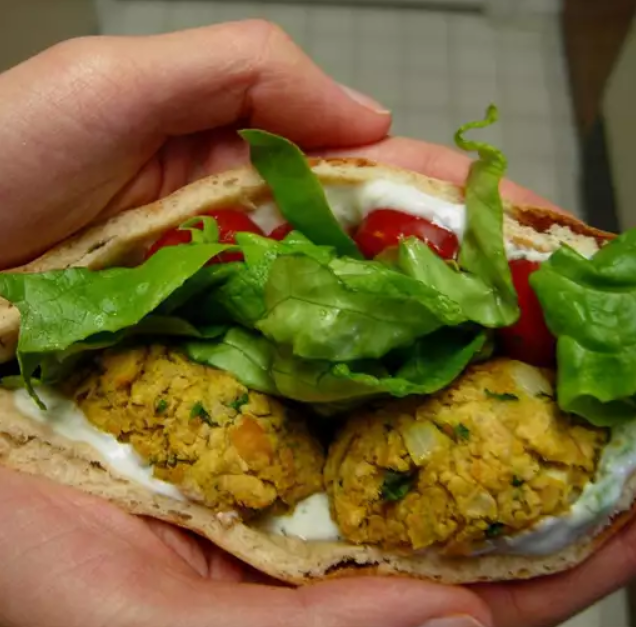
Introduction:
Transport your taste buds to the bustling streets of the Middle East with a culinary adventure that marries crispy falafel, soft pita bread, and creamy tahini sauce. This timeless combination not only delights the palate but also offers a nutritious and satisfying meal. Whether you’re a seasoned chef or a novice in the kitchen, crafting pita bread with falafel and tahini sauce is a breeze. Let’s dive into the art of creating this flavorful dish, step by step.
Ingredients:
- For the Falafel:
- 1 cup dried chickpeas, soaked overnight
- 1 small onion, roughly chopped
- 3 cloves garlic
- 1 cup fresh parsley, chopped
- 1 teaspoon ground cumin
- 1 teaspoon ground coriander
- 1/2 teaspoon baking powder
- Salt and pepper to taste
- Vegetable oil for frying
- For the Tahini Sauce:
- 1/2 cup tahini paste
- 1/4 cup water
- 2 tablespoons lemon juice
- 2 cloves garlic, minced
- Salt to taste
- For Serving:
- Pita bread
- Lettuce, tomatoes, cucumbers (optional)
- Pickles (optional)
- Hot sauce or harissa (optional)
Instructions:
- Making the Falafel: a. Drain the soaked chickpeas and add them to a food processor along with chopped onion, garlic, parsley, cumin, coriander, baking powder, salt, and pepper. b. Pulse the mixture until it forms a coarse paste. Make sure not to over-process; the texture should be slightly grainy. c. Transfer the falafel mixture to a bowl and refrigerate for 1-2 hours to firm up. d. After chilling, shape the falafel mixture into small balls or patties. e. Heat vegetable oil in a frying pan over medium heat. Fry the falafel in batches until golden brown and crispy, about 3-4 minutes per side. Drain on paper towels to remove excess oil.
- Preparing the Tahini Sauce: a. In a small bowl, whisk together tahini paste, water, lemon juice, minced garlic, and salt until smooth and creamy. Adjust the consistency by adding more water if necessary.
- Assembling the Dish: a. Warm the pita bread either in a toaster or over an open flame for a few seconds on each side. b. Spread a generous dollop of tahini sauce inside each pita pocket. c. Fill the pitas with falafel, lettuce, tomatoes, cucumbers, pickles, and a drizzle of hot sauce or harissa, if desired. d. Serve immediately and enjoy the burst of flavors with every bite!
Serving Tips:
- Create a Falafel Bar: Set up a DIY falafel bar for gatherings or family meals. Lay out bowls of fresh toppings like shredded lettuce, diced tomatoes, sliced cucumbers, and pickles alongside warm pita bread and a bowl of creamy tahini sauce. Let everyone customize their falafel wraps to their liking.
- Pair with Fresh Salads: Serve your falafel alongside vibrant salads for a complete and balanced meal. Try a traditional tabbouleh salad with parsley, mint, tomatoes, and bulgur wheat, or opt for a simple Mediterranean salad with cucumbers, olives, and feta cheese.
- Add a Side of Hummus: Enhance the Middle Eastern flavors by serving falafel with a side of creamy hummus. The combination of chickpeas in both the falafel and hummus creates a harmonious and satisfying meal.
- Grill the Pita Bread: For an extra layer of flavor and texture, lightly grill the pita bread before assembling the falafel wraps. This will impart a smoky aroma and a slightly crispy texture to the bread, elevating the overall dining experience.
- Garnish with Fresh Herbs: Before serving, garnish your falafel wraps with a sprinkle of fresh herbs like chopped parsley, cilantro, or mint. Not only does this add a pop of color, but it also enhances the freshness and aroma of the dish.
Storage Tips:
- Freeze Extra Falafel: If you have leftover falafel, allow them to cool completely before transferring them to an airtight container. Freeze for up to one month. To reheat, bake in a preheated oven at 350°F (175°C) for 10-15 minutes or until heated through.
- Reheat Pita Bread: To revive leftover pita bread, wrap them in aluminum foil and warm in a preheated oven at 300°F (150°C) for 5-10 minutes. Alternatively, you can lightly toast them in a toaster or on a skillet over medium heat.
- Store Tahini Sauce Properly: Store any leftover tahini sauce in a sealed container in the refrigerator for up to one week. Before using, give it a good stir as it may separate during storage. If the sauce thickens, simply stir in a splash of water to reach the desired consistency.
- Keep Toppings Fresh: Store leftover salad toppings such as lettuce, tomatoes, and cucumbers separately in airtight containers in the refrigerator. They will stay fresh for 2-3 days and can be used for other meals or snacks.
- Portion Control: If you’re meal prepping falafel wraps for later consumption, consider assembling the components separately and only assembling them just before serving. This helps maintain the integrity of the ingredients and prevents sogginess.
Variations:
- Vegetarian Twist: For a vegetarian version, swap out the traditional falafel with a different protein option such as grilled halloumi cheese or marinated tofu. Slice the halloumi cheese and grill until golden brown, or marinate tofu in a mixture of soy sauce, garlic, and spices before grilling or baking until crispy.
- Spicy Kick: Add some heat to your falafel by incorporating diced jalapeños or a pinch of cayenne pepper into the falafel mixture. You can also drizzle the assembled falafel wraps with a spicy chili sauce or sprinkle them with red pepper flakes for an extra kick.
- Herb Infusion: Experiment with different herbs and spices to customize the flavor of your falafel. Try adding fresh cilantro, mint, or dill to the falafel mixture for a refreshing twist. You can also mix in ground sumac or za’atar for a Middle Eastern flavor profile.
- Gluten-Free Option: Make the dish gluten-free by using gluten-free pita bread or lettuce wraps instead of traditional pita bread. You can also replace the chickpeas in the falafel with a combination of cooked quinoa and mashed sweet potatoes for a nutritious and gluten-free alternative.
- Protein Boost: Amp up the protein content of your falafel wraps by adding cooked lentils or black beans to the falafel mixture. Simply blend the cooked lentils or beans with the chickpeas and other ingredients in the food processor until combined. This not only adds nutritional value but also creates a heartier texture.
- Asian Fusion: Put an Asian twist on the classic falafel wrap by substituting the tahini sauce with a creamy peanut sauce. Mix together peanut butter, soy sauce, lime juice, garlic, and a dash of sriracha for a flavorful and tangy sauce. Serve the falafel wraps with shredded cabbage, carrots, and sliced cucumbers for added crunch.
- Breakfast Falafel: Transform falafel into a breakfast delight by serving it with scrambled eggs, avocado slices, and salsa wrapped in warm pita bread. You can also add crispy bacon or smoked salmon for an indulgent twist. This savory breakfast option is perfect for a leisurely weekend brunch.
- Sweet and Savory Fusion: Combine sweet and savory flavors by adding chopped dried fruits such as apricots or raisins to the falafel mixture. The natural sweetness of the fruits pairs beautifully with the aromatic spices and creates a unique flavor profile. Serve the falafel wraps with a drizzle of honey or a dollop of fruit chutney for an extra touch of sweetness.
FAQs (Frequently Asked Questions):
- Can I use canned chickpeas for the falafel?
- While canned chickpeas can be used in a pinch, dried chickpeas are preferred for falafel as they yield a better texture. If using canned chickpeas, make sure to drain and rinse them well before proceeding with the recipe. You may need to adjust the consistency of the falafel mixture by adding a bit more flour or breadcrumbs to compensate for the extra moisture.
- How do I prevent my falafel from falling apart while frying?
- To prevent your falafel from falling apart, make sure the mixture is well-blended but still slightly coarse. Refrigerating the mixture for at least an hour before shaping and frying helps it firm up and hold its shape better. Additionally, adding a binding agent like flour or breadcrumbs can help improve the texture and stability of the falafel.
- Is tahini sauce the same as hummus?
- While both tahini sauce and hummus contain tahini paste (ground sesame seeds), they are not the same. Tahini sauce is a creamy dressing made from tahini paste, water, lemon juice, garlic, and salt. It is thinner in consistency and used as a sauce or dip. Hummus, on the other hand, is a thick spread or dip made from tahini paste, chickpeas, lemon juice, garlic, and olive oil.
- Can I make falafel and tahini sauce ahead of time?
- Yes, both falafel and tahini sauce can be made ahead of time. Falafel can be shaped into balls or patties and stored in the refrigerator for up to 24 hours before frying. Cooked falafel can also be frozen for longer storage. Tahini sauce can be prepared in advance and stored in an airtight container in the refrigerator for up to one week. Give it a good stir before serving as it may thicken during storage.
- Can I bake falafel instead of frying?
- Yes, falafel can be baked instead of fried for a healthier alternative. Simply place shaped falafel on a baking sheet lined with parchment paper and lightly brush them with oil. Bake in a preheated oven at 375°F (190°C) for 20-25 minutes, flipping halfway through, until golden brown and crispy.
- Are falafel wraps suitable for a vegan diet?
- Yes, falafel wraps can be made vegan-friendly by using plant-based ingredients. Ensure that the falafel mixture does not contain any animal products such as eggs or dairy. Use vegan-friendly pita bread and tahini sauce, and fill the wraps with fresh vegetables and toppings of your choice.
Conclusion:
In conclusion, crafting pita bread with falafel and tahini sauce is a delightful journey into the vibrant flavors of Middle Eastern cuisine. With simple ingredients and easy-to-follow instructions, you can create a mouthwatering dish that satisfies both the palate and the soul. Whether enjoyed as a quick lunch, a family dinner, or a party appetizer, falafel wraps offer versatility, flavor, and nourishment.
By following the serving tips, storage advice, exploring variations, and addressing common FAQs, you can elevate your falafel-making skills and tailor the dish to suit your preferences and dietary needs. From vegetarian twists to spicy kicks and gluten-free options, there’s a falafel variation for every taste and occasion.
